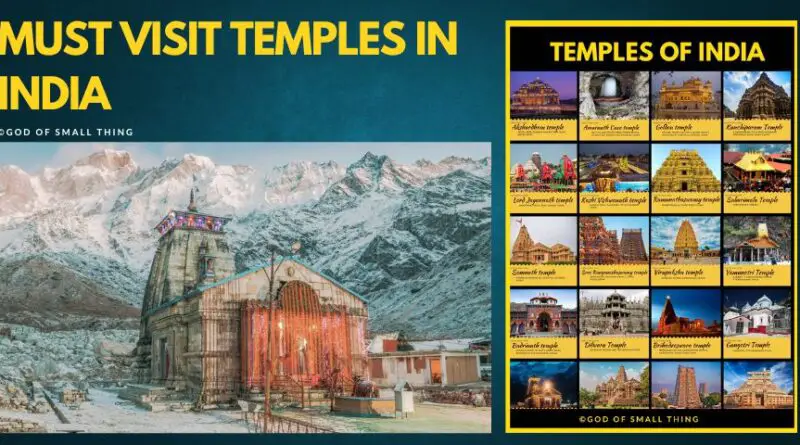Complete Travel Guide to Famous and Best Temples in India
There are numerous religious buildings in India. From tiny outcroppings in the middle of roads to massive, hewn-from-rock temples, these structures cover a wide range of sizes. Both lavishly gilded and relatively low-key examples can be found. Some Indian temples are decorated with explicit images and carvings. If you plan on visiting a temple, remember that no matter how big or small it is, you must always remove your shoes before entering. These are some of the most famous temples in India.
Best Temples in India
- Sri ramanathaswamy
- Great mahabodhi temple
- Ranakpur temple
- Akshardham temple
- Kailasa temple
- Lotus temple
- Khajuraho group of temple
- Virupaksha temple
- Meenakshi temple
- Golden Temple
- Somnath temple
- Kashi Vishwanath temple
- Tirupati balaji temple
- Padmanabhaswami temple
- Lord jagannath temple
- Dwarkadhish temple
- Amarnath cave temple
- Kedarnath temple
- Badrinath temple
- Gangotri temple
Temple of Sri Ramanathaswamy
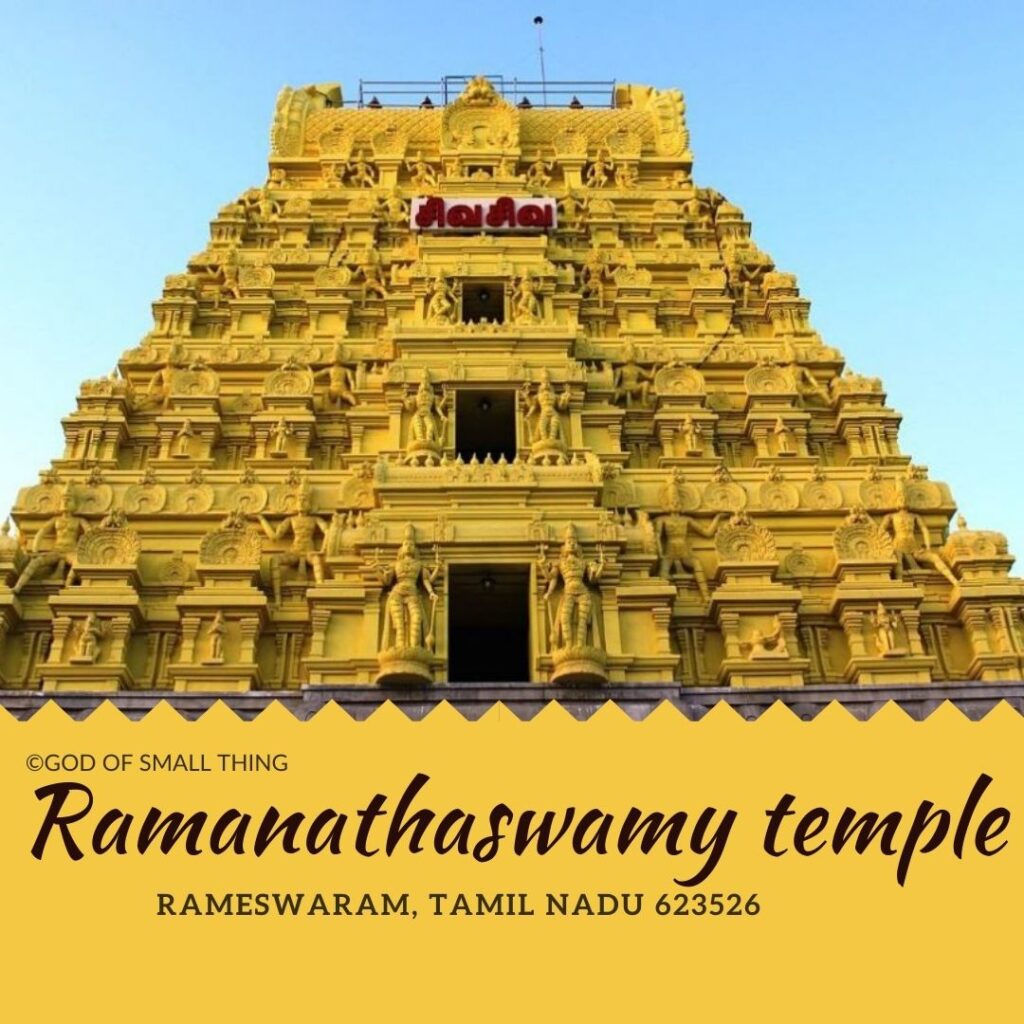
Location: Sri Ramanathaswamy Temple Location
Best time to visit: 9AM to 1PM
Temple of Sri Ramanathaswamy history: Dedicated to Shiva, this temple can be found on Rameswaram Island in Tamil Nadu. There is one of the twelve Shiva relics called jyotirlingas housed there. One of the four holy sites that make up the Char Dham circuit for Hindu pilgrims is the Ramanathaswamy Temple. It is believed that if one visits all four, they will be cleansed of their sins from previous lives.
The massive Ramanathaswamy Temple has 22 sacred wells, a tower that soars 126 feet into the air to the east, and another tower that rises 78 feet into the air to the west, all enclosed by massive walls. The sea adjacent to the temple, known as Agnitheertham, is considered sacred. Pilgrims take a dip here before entering the temple for purification. The temple is adorned with exquisite sculptures and carvings depicting various mythological stories, adding artistic and cultural richness. Within the complex, there’s a separate shrine dedicated to Lord Hanuman with a unique idol having five faces. As far as I can tell, this temple has the longest corridor of any Hindu temple in India. Prior to entering the holiest part of the temple, devotees are required to wash in these sacred springs.
Temple of the Great Enlightenment (Mahabodhi)
Location: Mahabodhi Temple Location
Best time to visit: 9AM to 1PM
Temple of the Great Enlightenment (Mahabodhi) history: Mahabodhi Temple is among the oldest brick buildings in eastern India, constructed in the late Gupta period.

Located in the Buddhist holy city of Bodhgaya, this complex is of the utmost religious significance. It occupies the traditional location of the moment when Siddhartha Gautama, better known as Buddha, realized the truth. According to Buddhist cosmology, this is where our current planet will come to an end, and where the next one will begin to form. The Mahabodhi Temple in Gaya, India, is a UNESCO World Heritage site and a significant Buddhist pilgrimage destination. The temple’s architecture, reflecting various historical periods, adds to its charm, making it a sacred and culturally rich site.
Additionally, A huge statue of a seated Buddha covered in gold and wearing a bright orange robe can be found inside the temple. The Mahabodhi Temple complex is also famous for being home to a descendant of the original Bodhi Tree, which was the peepal tree under which Buddha was said to have attained enlightenment. The entire Bodhgaya city had many different monasteries and temples dedicated to different countries, like Chinese temples, Thai temples, Japanese temples etc. Another main attraction of the place is the 80 Ft. Statue where Budda is present in a meditating position and the Lake where Buddha meditated for years. This place is a must-visit.
Temple of Ranakpur
Location: Ranakpur Temple Location
Best time to visit: October – February
Temple of Ranakpur history: The idol of Parshvanatha is exquisitely sculpted from a single block of marble. The snake-headed idol has 1,008 heads and a plethora of tails. Yaksha and yakshi, who are half-human and half-snake, stand on either side of the two chauri-bearers. Both of Parshvanatha’s elephants are bathing in a sacred spring.
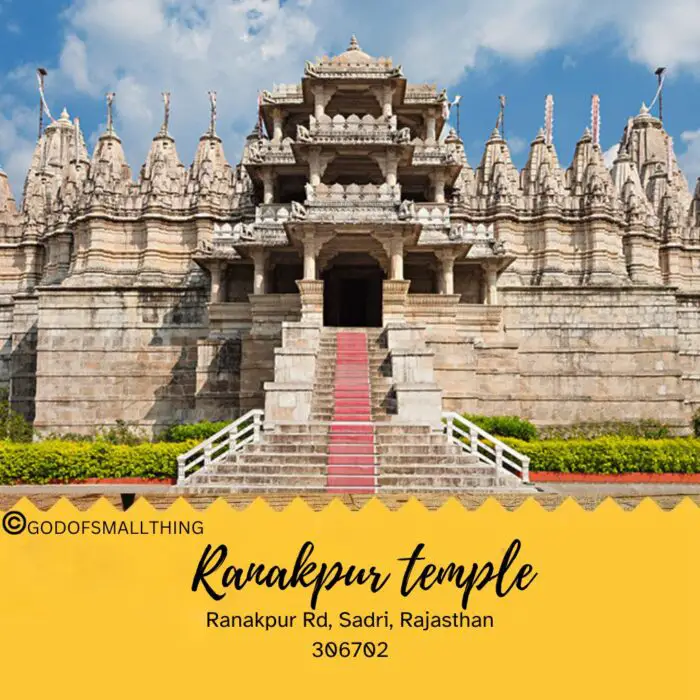
The Ranakpur Temple is a major Jain pilgrimage site in India and one of the largest and most significant in the world. It has 29 halls and 80 domes and is built of white marble. The structure is also well-known for its 1,444 hand-carved marble pillars. Depending on the time of day, these columns can look either golden or pale blue. The beautiful temple at Ranakpur is covered in intricate carvings depicting everything from flowers to geometric patterns. This temple, found in the small town of Ranakpur between the cities of Udaipur and Jodhpur, is only accessible to visitors in the late afternoon. You should prepare adequately for your trip.
Akshardham Temple
Location: Akshardham Temple Location
Best time to visit: Tuesdays and Sundays from 09:30 am to 07:30 pm.
Akshardham Temple history: The Akshardham Temple was constructed in 2005, making it one of the more recent well-known temples in India.The temple is inspired and developed by Pramukh Swami Maharaj, the spiritual leader of BAPS, following the teachings of Bhagwan Swaminarayan (1781–1830), the founder of the Swaminarayan tradition. The temple complex showcases a blend of traditional Indian architectural styles. The main monument, the Akshardham Mandir, is built using pink sandstone and white marble, with intricate carvings depicting various deities, flora, fauna, and scenes from Hindu scriptures.
Our personal recommendation would be to try and visit Mathura and Vrindavan for sure when on a cultural trip to India. And here is a Complete Travel Guide to Famous and Best Temples in Vrindavan and Mathura that can help 🙂
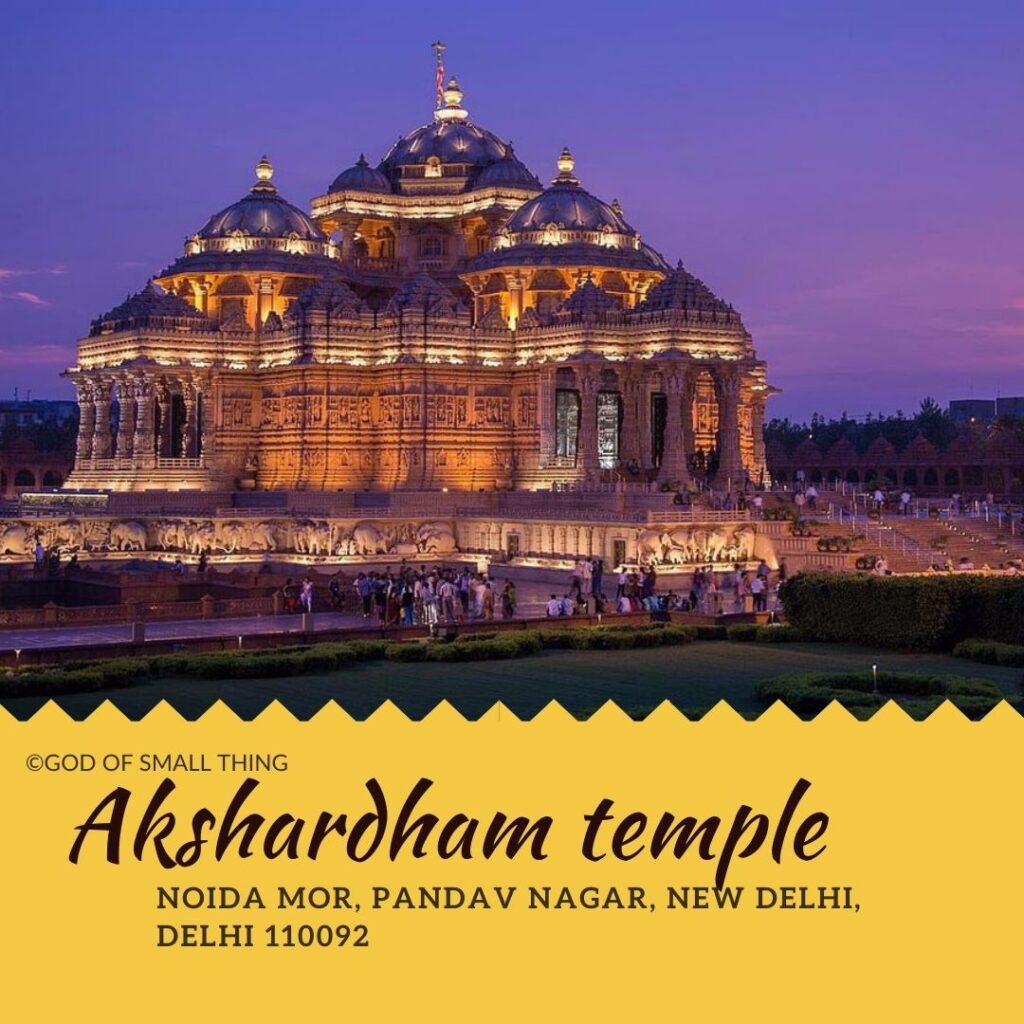
It is the world’s largest Hindu temple and is found in the eastern suburbs of New Delhi; it was built using traditional methods. Even though it is a brand spanking new, it pays tribute to its predecessors with beautiful, ornately carved sandstone reliefs. This magnificent temple, standing tall and alone in the center of the complex, has a presence reminiscent of a fairy tale as you make your way up to it. Along with its gilded 11-foot-tall statue of Bhagwan Swaminarayan, for whom the temple is named, the Akshardham Temple complex on the Yamuna River also features a boat ride that will take you on a journey through India’s history and a musical fountain show.
Temple of Kailasa
Location: Kailasa Temple Location
Best time to visit: December when the Indian Classical Music Festival is held.
Temple of Kailasa history: In 760 AD, King Krishna I had this temple hewn out of a massive boulder using only chisels, hammers, and picks. There is no dedicatory inscription at the Kailasa temple, but it was undoubtedly commissioned by a Rashtrakuta king. Two inscriptions associated with the name “Krishnaraja” (IAST Karja) at the temple’s entrance suggest that the Rashtrakuta king Krishna I (r. 756-773 CE) was responsible for its construction.
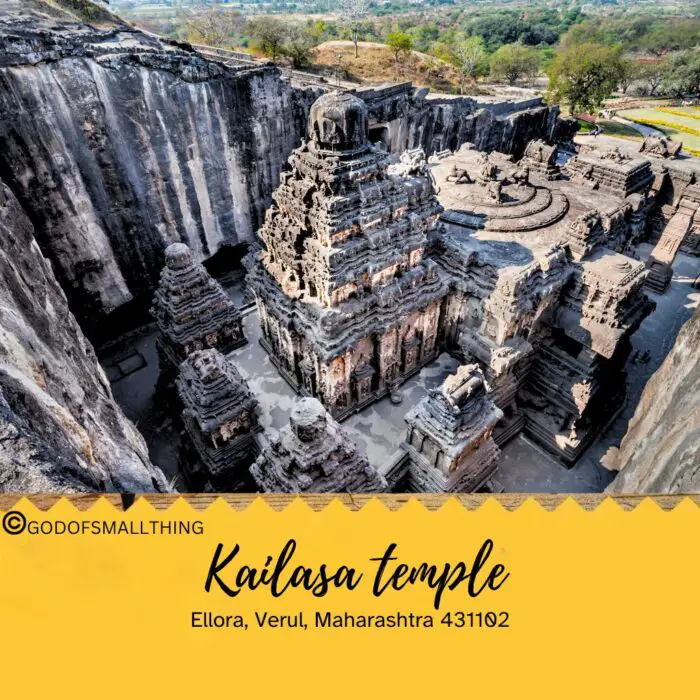
The Kailasa Temple in Ellora, Maharashtra, is one of the most impressive ancient structures ever built by humans. Some have even speculated that extraterrestrials constructed this temple, as it so closely resembles Mt. Kailasa, the deity Shiva’s home. Seeing Kailasa Temple will make it clear why this is the case. Despite its plain exterior, the temple’s interior is rich with reliefs and intricate carvings, and its columns are made of solid rock. There are 34 artificial caves at the location, including the temple. There are 12 Buddhist caves, 17 Hindu, and 5 Jain caves.
Lotus Temple
Location: Lotus Temple Location
Best time to visit: October to March
Lotus Temple History: This fascinating temple, constructed like a lotus flower, was first opened to the public in 1986. In December of 1986, the Lotus Temple was dedicated and officially opened to the public. Even before construction was finished, Iranian architect Fariborz Sahba received praise for his work on the temple’s design. Several prizes were later bestowed upon it. The shape of the Lotus Temple inspired its namesake flower.
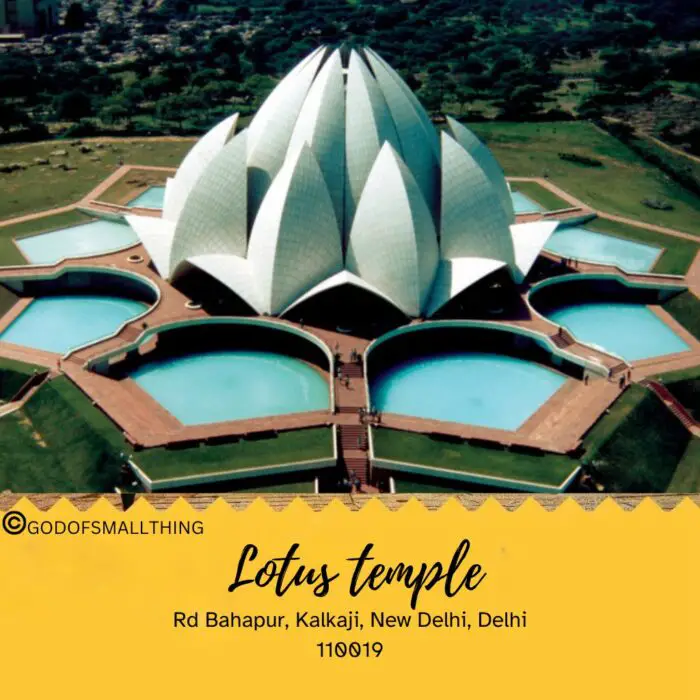
Located in New Delhi, the Lotus Temple is also referred to as the Bahai House of Worship and the Bahai Mashriqul-Adhkar Temple. The Lotus Temple is open to people of all faiths because Bahaism emphasizes the “Oneness of God, the Oneness of Religions, and the Oneness of Humanity.” Furthermore, no sermons may be delivered in this temple under any circumstances. The Lotus Temple is another stunning building. The building’s 27 marble petals are what gives it the distinctive Lotus shape; they were designed by Iranian architect Fariborz Sahba.
Temples of Khajuraho
Location: Khajuraho Temple Location
Best time to visit: October to February
Temples of Khajuraho history: The Khajuraho Temples were constructed in Madhya Pradesh between 900 and 1130 AD by the Chandela dynasty. The Chandella dynasty, which ruled from 950 to 1050, is credited with constructing the Khajuraho temples. There are only about twenty temples left, and they are spread out among three categories and two religions: Hinduism and Jainism. They successfully combine architectural elements with sculptural ones.
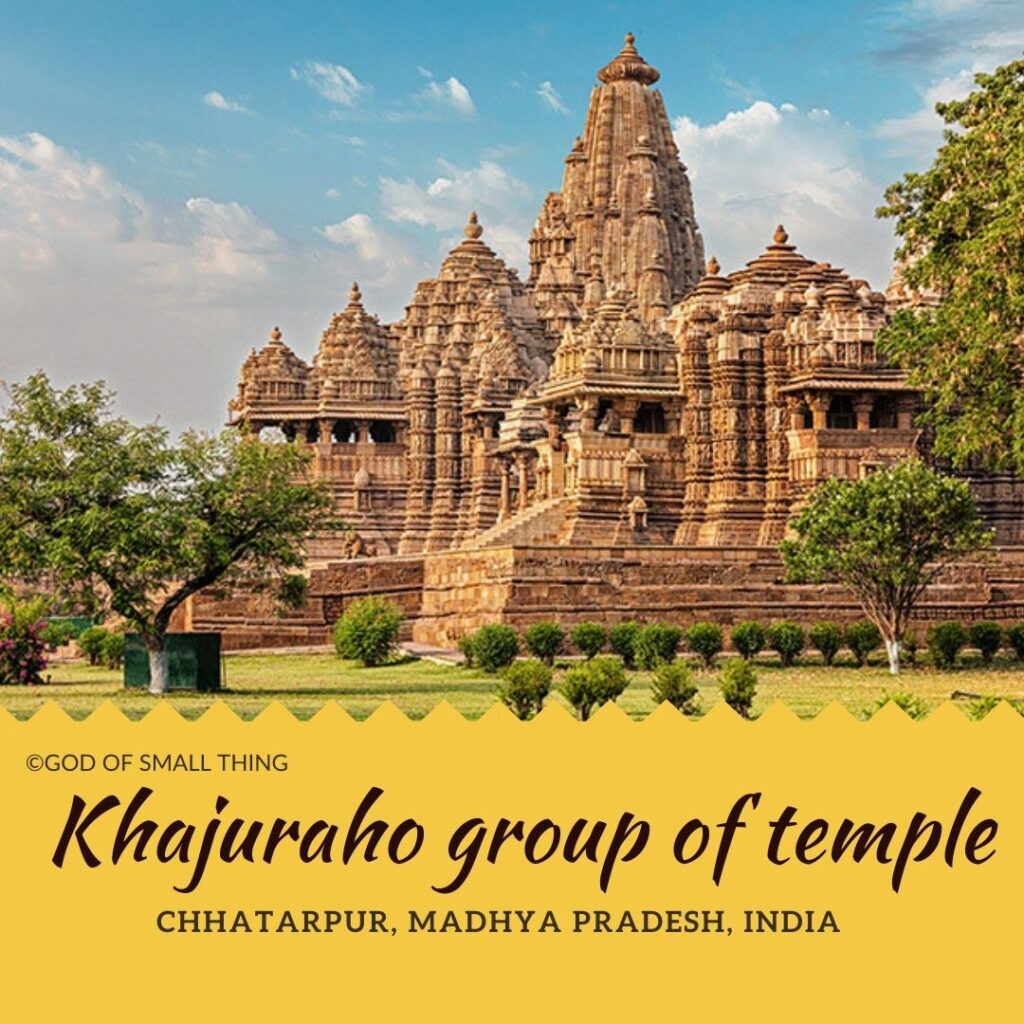
These religious buildings are not for the faint of heart, as they feature blatantly erotic carvings. However, if you approach them with an open mind, you may find these temples to be truly impressive. There may have been as many as 85 temples in the region, but only 25 are still standing today. For reasons that are not entirely clear, many Jain and Hindu temples feature intricate carvings depicting sexually explicit encounters between humans and other animals. One theory suggests that the carvings were created to celebrate the Kama, or the seeking of pleasure, one of the four noble aims recognized by Hinduism.
Temple of Virupaksha
Location: Virupaksha Temple Location
Best time to visit: 9 AM to 1 PM
Temple of Virupaksha History: Located on the banks of the Tungabadra River, this temple has been open to worshippers since the 7th century AD, making it India’s longest continuously operating religious structure. Vijayanagar, once the capital of the Vijayanagar empire, included the Virupaksha Temple as part of its royal city.

While the temple has survived to the present day, the rest of the city is largely in ruins. The three towers of the Virupaksha Temple are devoted to the Hindu god Shiva, who is honoured under his local name, Virupaksha. Get Lakshmi, the temple elephant, to bless you while you’re at Virupaksha Temple. It’s possible, if you arrive early enough, to catch an elephant as it takes its morning bath.
If you are enthusiastic about visiting Jyotirlingas, check this guide out. There are 12 jyotirlingas in India. The 12 Jyotirlingas are the most visited and renowned Temples of Lord Shiva. If you are a devotee of Lord Shiva or if you love to go on spiritual trips – you must visit all the 12 Jyotirlingas. Read this article to sort out your Travel requirements and embark on this journey. – Complete Travel Guide to 12 Jyotirlingas in India – Temples of Lord Shiva
Meenakshi Amman Temple
Location: Meenakshi Amman Temple Location
Best time to visit: Morning 5 to 6:30 is the first pooja timing. The temple opens at 4:30 am.
Meenakshi Amman Temple history: It is dedicated to Shiva and his consort Parvati and is located in Tamil Nadu on the banks of the Vaigai River. It has 14 towers covered in 33,000 colourful sculptures. As part of his campaign to convert the region to Islam, the Muslim general Malik Kafur destroyed the original temples that had stood here since the sixth century BC. In 1559, however, Madurai’s first Nayak king ordered the temples to be rebuilt.

The more significant temples in India tend to have a more subdued colour scheme. And indeed not the Meenakshi Amman Temple, a riot of colour. Once bare, the statues atop the towers now burst with the vibrant colours seen today thanks to the years of festival paint jobs. The temple is adorned with towering gopurams, with the tallest being the southern tower, standing at about 170 feet. The gopurams are adorned with thousands of colourful sculptures depicting various mythological stories. The temple has a sacred tank known as Potramarai Kulam or Golden Lotus Tank, adding to the spiritual ambience.
Golden Temple
Location: Golden Temple Location
Best time to visit: is between 4 pm and 7 pm
Golden Temple history: Legend has it that Buddha visited this area, and two thousand years later, the Sikh religion’s founder, Guru Nanak, made his home in the area around the lake. It was founded by Guru Ram Das, the fourth Sikh Guru, in the 16th century. Construction of the temple was initiated by Guru Arjan, the fifth Guru, and completed in 1604. The Golden Temple is a symbol of Sikhism’s spiritual and cultural heritage.
The temple’s central sanctum, covered in gold leaf, houses the Guru Granth Sahib, the Sikh holy scripture. Over the centuries, the Golden Temple has undergone renovations and expansions, becoming a significant pilgrimage site and a symbol of Sikh resilience and faith.

This beautiful temple is the holiest of all Sikh shrines, and it is located in the middle of a small sacred lake. The temple got its name because its exterior is covered in gold panels and its dome is covered in gold. Amritsar, Punjab is home to the fascinating Golden Temple, which has a long and intriguing history. Sometime later, worshippers of his established a temple there. Try to time your visit to the temple so that you can witness either the morning or evening ceremony in which the Guru Granth Sahib (the Sikh holy book) is installed into the temple or is returned to the Akal Takht (the Sikh parliament).
Somnath Temple, Gujarat
Location: Somnath Temple Location
Best time to visit: October, November, December, January, February, and March
Somnath Temple, Gujarat history: Several ancient texts, such as the Rigveda, the Shivpuran, and the Shreemad Bhagavat, make reference to this temple.

It’s no secret that the Somnath Temple is a popular destination for tourists and devotees alike. The western coast of Gujarat is where you’ll find this temple. Shree Somnath Jyotirling Temple is highly respected by Shiva worshippers because it is considered to be one of the twelve Jyotirlingas or holy sites in India thought to be the places where Shiva first appeared to his devotees.
Varanasi’s Shri Kashi Vishwanath Temple
Location: Varanasi’s Shri Kashi Vishwanath Temple Location
Best time to visit: 3 AM -11 PM
Varanasi’s Shri Kashi Vishwanath Temple history: Several Muslim kings had previously destroyed this ancient Shiva temple, most recently the sixth Mughal emperor, Aurangzeb. In the 1780s, Maratha ruler Ahilyabai Holkar of Indore built the current structure in the area. The governments of India and Uttar Pradesh have recently renovated the temple.

Vishvanatha and VishveshvaraKashi are both names for Lord Shiva which translate to “Ruler of the Universe.” If you’re looking for a famous Hindu temple dedicated to Shiva, look no further than the Vishvanath Temple. One of the twelve sacred temples dedicated to the worship of the Jyotirlinga can be found right here. Varanasi, Uttar Pradesh, India, is where you’ll find it. You can find the temple on the western bank of the world-famous Ganga.
Temple of Lord Balaji (Tirupati)
Location: Lord Balaji (Tirupati) Temple Location
Best time to visit: September to February
Temple of Lord Balaji (Tirupati) history: According to various faiths, Lord Vishnu descended to Earth to rescue its inhabitants from the tribulations of the Kali Yuga. Tirupati is the place where Lord Venkateshvara, the Hindu god of seven hills, resides. Located in Sri Venkateshwara Sanctuary and National Park, the holy hill of Tirumala is about 6 miles (10 km) northwest of Tirupati. Before 1870, non-Hindus were forbidden from climbing the hill because of its sacred status.
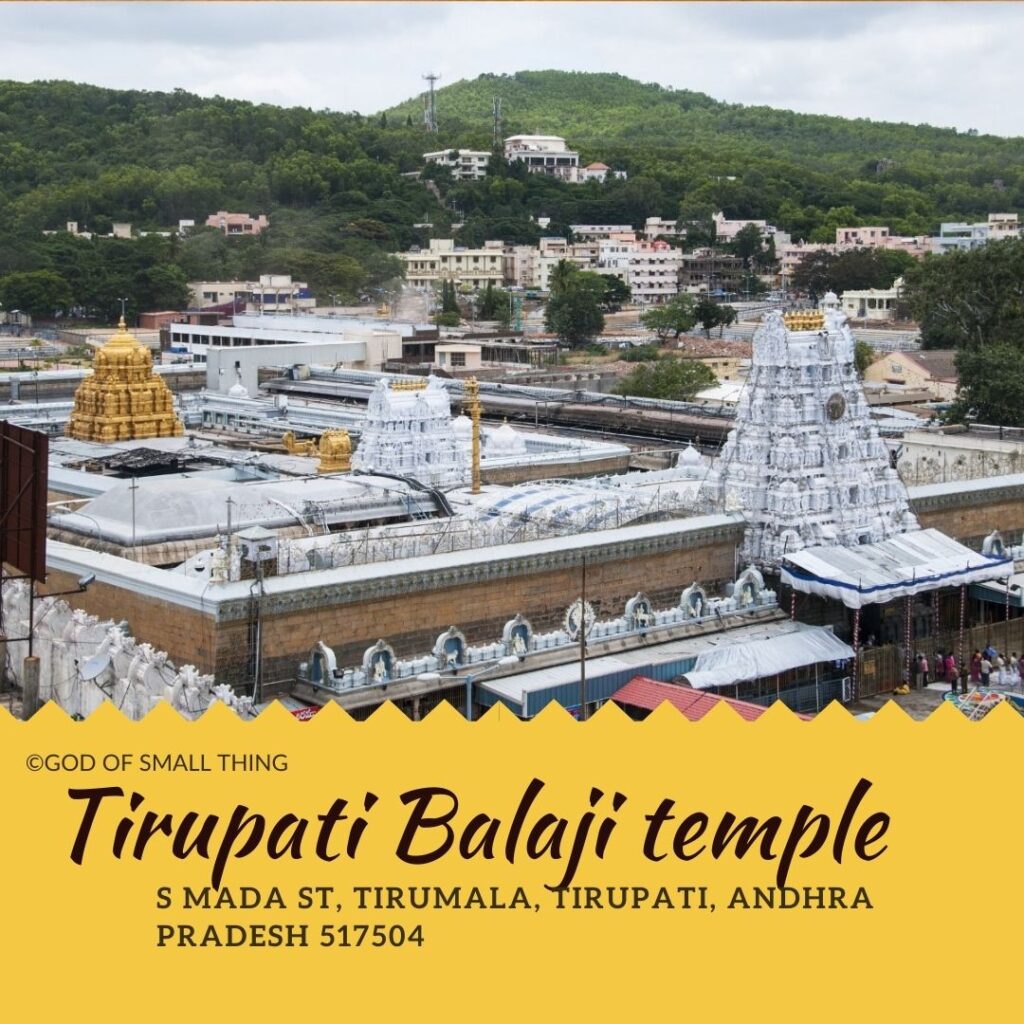
Tirupati Balaji Temple, also known as Sri Venkateswara Swami Vaari Temple, is a major destination for Hindu devotees. The hill town of Tirumala in the Indian state of Andhra Pradesh is home to the Sri Venkateswara Swami Vaari Temple. The deity venerated there is Venkateswara, an incarnation of Vishnu. Footprints of Lord Venkateswara are believed to be imprinted on a rock, located on a hill named Narayanagiri. The innermost chamber where the main deity resides, attracts millions of devotees annually. The famous sweet offered as prasad to the devotees, is known for its unique taste and is considered a divine offering
Sree Padmanabhaswamy Temple
Location: Sree Padmanabhaswamy Temple Location
Best time to visit: between 8am and 10 am
Sree Padmanabhaswamy Temple history: Hindus believe the Sree Padmanabhaswamy temple to be at least 5,000 years old. On January 17, 1750, Anizham Thirunal gave the temple’s primary deity, Padmanabhaswamy, control of the Kingdom of Travancore and swore that he and his descendants would serve as Padmanabha Dasa, vassals or agents of the deity.
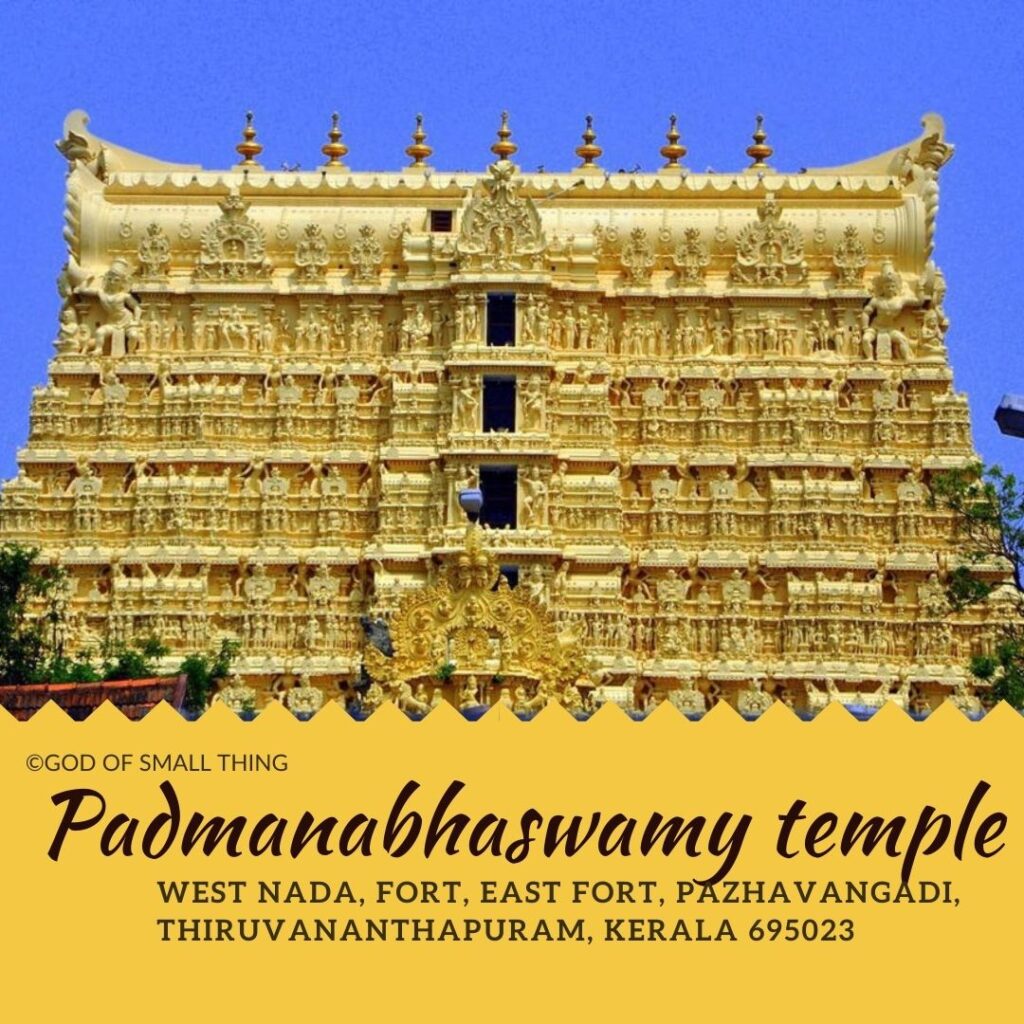
Sree Padmanabhaswamy Temple is located in Thiruvananthapuram, Kerala. This holy shrine is considered to be one of the 108 Divya Desams. Padmanabhaswamy Temple, dedicated to an incarnation of Vishnu known as Lord Padmanabha, is a major center of Vaishnava worship, by Vaishnava dharma. An allusion to the Padmanabhaswamy Temple can be found in the Bhagwad Gita.
Temple of Shri Jagannath in Puri
Location: Shri Jagannath in Puri Temple Location
Best time to visit: before 6 am
Temple of Shri Jagannath in Puri history: The three main deities are dragged around on large, ornately decorated temple vehicles during the annual Ratha Yatra festival in the Puri temple. King Indradyumna of Malwa in the Kali Yuga was determined to track down the enigmatic picture, and he was willing to undergo severe penance to do so. Vishnu then told him to find a log floating off the coast of Puri so that he could carve an image into its trunk. The King came across the wooden hunk.
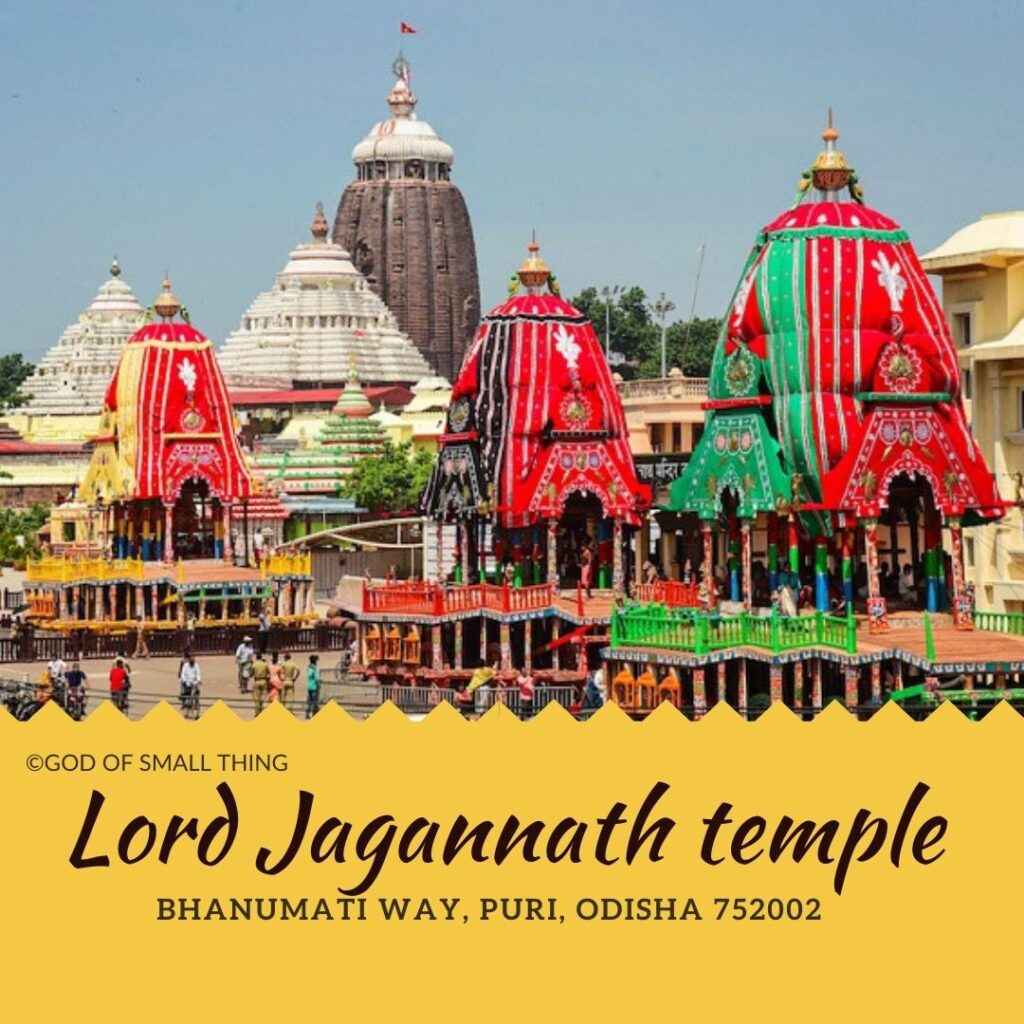
This is Odisha, where Lord Jagannath was born. Puri, Odisha is home to the revered Jagannath Temple. One of the four holy sites (Char Dham) that travelers must visit is the Puri Jagannath Temple. The sanctum sanctorum houses the idols of Lord Jagannath, Balabhadra, and Subhadra. Non-Hindus are not allowed inside the temple. Located at a distance, it is believed to be the maternal home of Lord Jagannath. The deities stay here for a week during the Rath Yatra. The temple’s iconic blue wheel atop the main spire, is considered highly sacred.
The Dwarkadhish temple
Location: The Dwarkadhish Temple Location
Best time to visit: October to March
The Dwarkadhish temple history: Located on the Hindu pilgrimage route known as the Char Dham, this temple is devoted to Krishna, who is known as the “King of Dwarka” or Dwarkadhish in this region.

Dwarka is Krishna’s original city. Dwarka, in the Indian state of Gujarat, is home to the Jagat Mandir, also known as the Dawarladish Temple. Its central shrine, supported by 72 pillars, is called either Jagat Mandir or Nija Mandir, and it occupies the topmost floor of the five-story building. The earliest version of the temple was probably constructed around 2,200 years ago, according to archaeological evidence.
Temple of Amarnath
Location: Amarnath Temple Location
Best time to visit: Every year the Yatra starts around the start of June and usually ends in August.
Temple of Amarnath history: The legend states that the shepherd met a saint who gave him a bag of coal. When he got home, he was taken aback to find that his coal bag had been transformed into a treasure chest full of gold coins. The Amarnath cave in the Himalayas of South Kashmir is where Lord Shiva supposedly revealed to Parvati the secret of his immortality (Amar Katha). You’ll need to hike or ride a pony to get to this cave, which is 3,888 feet above sea level.

The Hindu temple of Amarnath can be found in the Anantnag area of the Indian state of Jammu and Kashmir. In this temple, the Shiva Lingam is a Swayambhu lingam. The cave is in Lidder Valley, which is located 168 kilometres from the city of Anantnag at an elevation of 3,888 meters above sea level. All year long, except for a short period during the summer when pilgrims can access it, it is blanketed in snow. The cave is surrounded by snowy, glacier-covered mountains.
Kedarnath Temple
Location: Kedarnath Temple Location
Best time to visit: Summer Season (April-June)
Kedarnath Temple history: One of the earliest mentions of Kedarnath can be found in the Skanda Purana, which describes Kedara (Kedarnath) as the spot where Lord Shiva untangled his matted hair to reveal the holy waters of the Ganges River. One of the twelve Jyotirlingas, the holiest Hindu shrines dedicated to Shiva, the temple is said to have been constructed by the Pandavas. It was expected that the Pandavas’ penance in Kedarnath would appease Shiva.
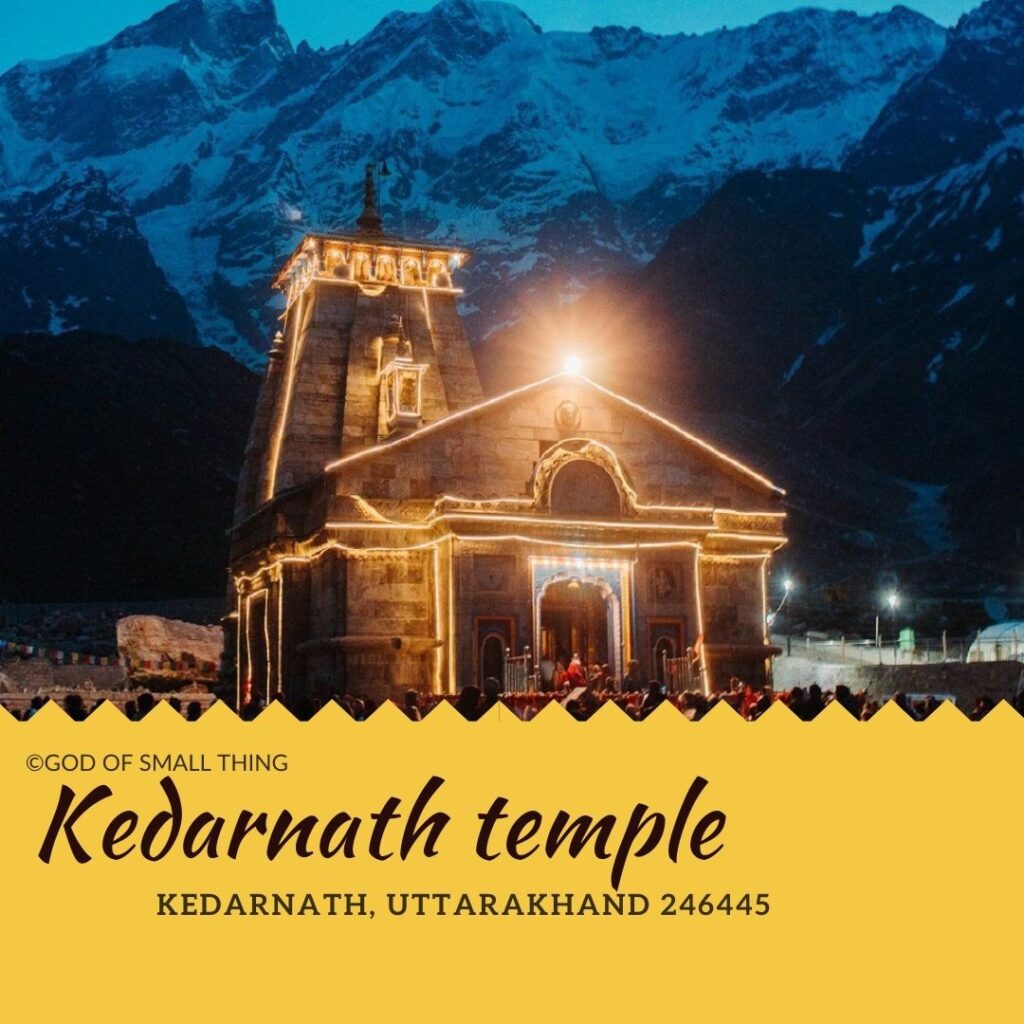
The town of Kedarnath, where the temple can be found, is in the Rudraprayag region of the Indian state of Uttarakhand. Lord Shiva is the focus of worship at this temple. The stunning backdrop of the Kedarnath Peak enhances the spiritual ambiance, creating a picturesque setting for the temple. Located near Kedarnath, this temple is dedicated to Bhairava, an incarnation of Lord Shiva, and is visited by pilgrims as part of the yatra. A glacial lake near Kedarnath, offering breathtaking views of the surrounding mountains.
Temple of Badrinath
Location: Badrinath Temple Location
Best time to visit: late April or early May
Temple of Badrinath history: A black Shaligram stone statue of Lord Badrinarayan is said to have been found by Adi Shankaracharya in the Alaknanda River. He had originally hidden it in a cave close to the Tapt Kund hot springs. The murti was brought to the current temple by the King of Garhwal in the sixteenth century. Shankara is said to have lived there for six years, from CE 814 to CE 820. He spent half the year in Kedarnath and the other half in Badrinath. Badrinath, a Hindu deity, is said to have been discovered by him in the Alaknanda River and then enshrined in a cave close to the Tapt Kund hot springs, at least according to the beliefs of his devotees.
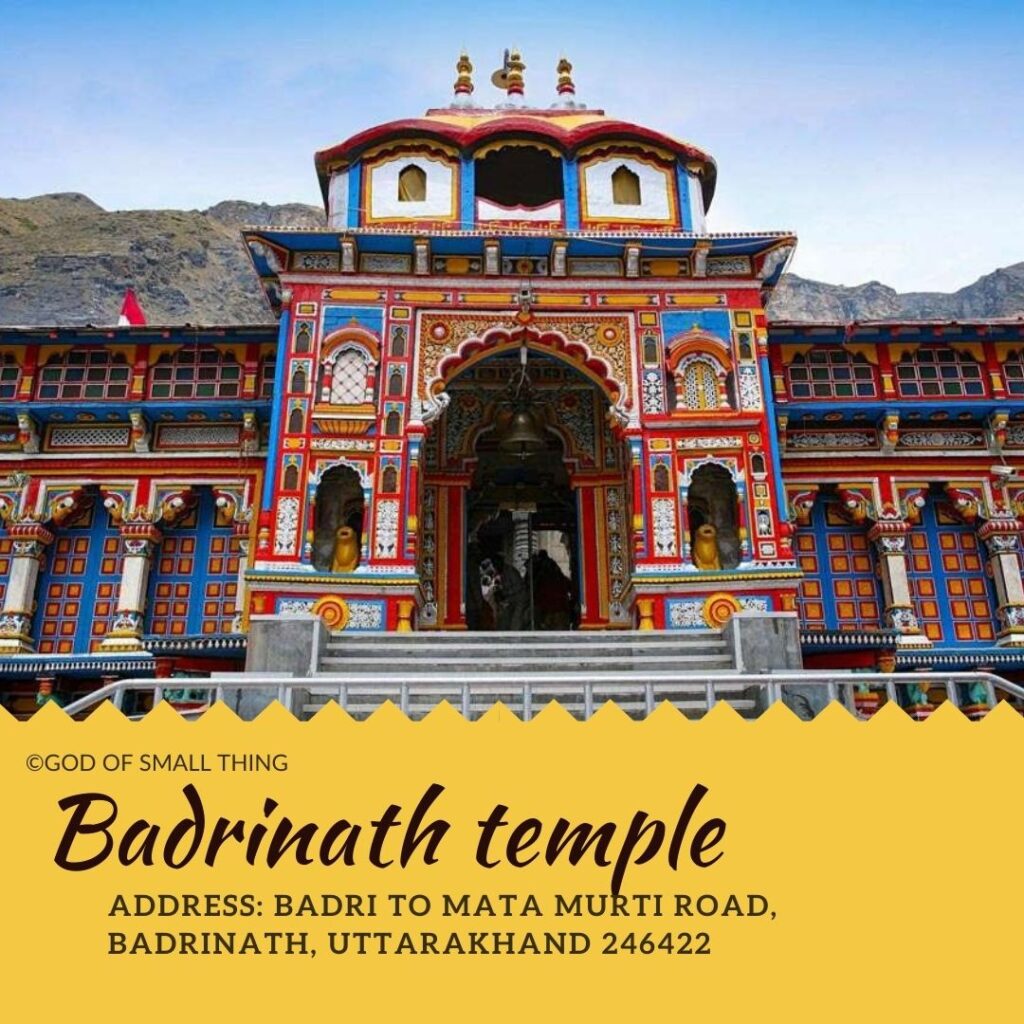
Since it is a holy site for Hindus, the Badrinath Temple is included in the Char Dham Jatra. Badrinath town and the Chamoli district of Uttarakhand are where you’ll find the temple. The town’s namesake Badrinath Temple draws the most visitors. A recess in the river, near Tapt Kund, where hot water springs up. Pilgrims believe that a dip here cleanses sins. A natural thermal spring with hot water near the temple believed to have medicinal properties. Pilgrims take a dip in its sacred waters before entering the temple. The majestic Neelkanth Peak forms a stunning backdrop to the temple, adding to the scenic beauty and spiritual ambience.
Gangotri Dham
Location: Gangotri Dham Temple Location
Best time to visit: between April and June, and September and October
Gangotri Dham history: This is the holiest temple to the goddess Ganga. The holy River Ganges, also called Bhagirathi, originates in the nearby Gangotri glacier. According to Hindu mythology, Lord Shiva let the mighty Ganges River flow free from his locks at Gangotri, making it descend from heaven to earth. The actual beginning of the river is located 19 kilometres away in the Gangotri glacier at a place called Gaumukh.

Pilgrims from Dham Chota Char Dham visit Gangotri Dham. Specifically, the town of Gangotri in the Uttarkashi district of the Indian state of Uttarakhand is where the temple can be found. Gangotri is famous for its Gangotri Temple, a place of worship dedicated to the Hindu goddess Ganga. The 20-foot white granite structure that serves as the temple is a sight to behold. Pilgrims often embark on a trek to the source of the Ganges River, the Gangotri Glacier, to witness the origin of the sacred river. A large rock near the temple is believed to be the spot where King Bhagirath meditated to bring the river Ganges down to Earth.
A trek from Gangotri leads to Gaumukh, the actual mouth of the Gangotri Glacier resembling the face of a cow, from where the Ganges originates. These attractions, coupled with the spiritual ambience and breathtaking natural beauty, make Gangotri Temple a significant pilgrimage site and a haven for nature enthusiasts.
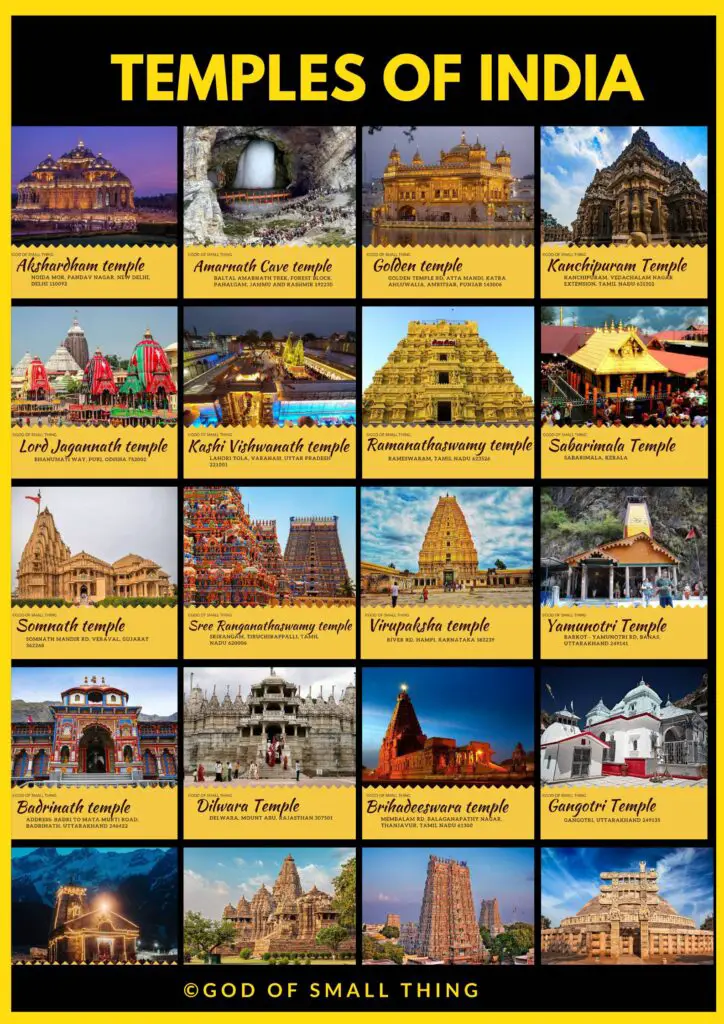
Some Frequently Asked Questions
As per Wikipedia, There are around two million temples in India, and each year the number increases substantially. As per Wikipedia, The Srirangam Temple is often listed as the largest functioning Hindu temple in the world. The temple, located in Tamil Nadu, occupies an area of 156 acres (631,000 m²) with a perimeter of 4,116m (10,710 feet), making it the largest temple in India and one of the largest religious complexes in the world.
As per Adda247.com, Top 10 Famous Temples in India 2022- 1. Shirdi, Shirdi Sai Baba, 2. Tirumala Venkateswara Temple, 3. Ramanathaswamy Temple, kedarnath temple, Kashi Vishwanath temple.
As per Wikipedia, The Srirangam Temple is often listed as the largest functioning Hindu temple in the world. The temple, located in Tamil Nadu, occupies an area of 156 acres (631,000 m²) with a perimeter of 4,116m (10,710 feet), making it the largest temple in India and one of the largest religious complexes in the world.
As per Wikipedia, There are many temples in India. Can’t choose one. As per Wikipedia, Kubera (Sanskrit: कुबेर, romanized: Kubera) also known as Kuvera, Kuber, and Kuberan, is the god of wealth, and the god-king of the semi-divine yakshas in Hinduism.
As per Wikipedia, In 2008, however, the German archaeologist Klaus Schmidt determined that Göbekli Tepe is, in fact, the oldest known temple in the world. As per Wikipedia, the East direction is sacred in Vastu because the sun rises from this direction, and the Sun is the sole energy giver.
As per Wikipedia, Hindu temples are known by many different names, varying on region and language, including Alayam, Mandir, Mandira, Ambalam, Gudi, Kavu, Koil, Kovil, Déul, Raul, Devasthana, Degul, Deva Mandiraya, and Devalaya.
As per Wikipedia, The Srirangam Temple is often listed as the largest functioning Hindu temple in the world. The temple, located in Tamil Nadu, occupies an area of 156 acres (631,000 m²) with a perimeter of 4,116m (10,710 feet), making it the largest temple in India and one of the largest religious complexes in the world.

